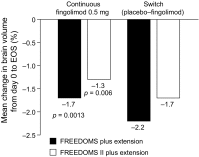Effect of Fingolimod on Brain Volume Loss in Patients with Multiple Sclerosis
- PMID: 28247239
- PMCID: PMC5374177
- DOI: 10.1007/s40263-017-0415-2
Effect of Fingolimod on Brain Volume Loss in Patients with Multiple Sclerosis
Abstract
Brain atrophy occurs at a faster rate in patients with multiple sclerosis (MS) than in healthy individuals. In three randomized, controlled, phase III trials, fingolimod reduced the annual rate of brain volume loss (BVL) in patients with relapsing MS (RMS) by approximately one-third relative to that in individuals receiving placebo or intramuscular interferon beta-1a. Analysis of brain volume changes during study extensions has shown that this reduced rate of BVL is sustained in patients with RMS receiving fingolimod continuously. Subgroup analyses of the core phase III and extension studies have shown that reductions in the rate of BVL are observed irrespective of levels of inflammatory lesion activity seen by magnetic resonance imaging at baseline and on study; levels of disability at baseline; and treatment history. The rate of BVL in these studies was predicted independently by T2 lesion and gadolinium-enhancing lesion burdens at baseline, and correlations observed between BVL and increasing levels of disability strengthened over time. In another phase III trial in patients with primary progressive MS (PPMS), fingolimod did not reduce BVL overall relative to placebo; however, consistent with findings in RMS, there was a treatment effect on BVL in patients with PPMS with gadolinium-enhancing lesion activity at baseline. The association between treatment effects on BVL and future accumulation of disability argues in favor of measuring BVL on a more routine basis and with a more structured approach than is generally the case in clinical practice. Despite several practical obstacles, progress is being made in achieving this goal.
Conflict of interest statement
Funding
Editorial and medical writing support for the development of this manuscript was funded by Novartis Pharma AG. Journal open-access costs were also met by Novartis Pharma AG.
Conflicts of Interest
NDS has received honoraria from Biogen-Idec, Genzyme, Merck Serono, Novartis, Roche, and Teva for consulting services, speaking, and travel support. He serves on advisory boards for Merck Serono, Novartis, Biogen-Idec, Roche, and Genzyme, and he has received research grant support from the Italian MS Society. DS is an employee of Novartis Pharma AG. MHB has received institutional support from Biogen, Genzyme, Merck, Novartis, and Teva, and is a research consultant for Medical Safety Systems.
Figures





Similar articles
-
Effect of fingolimod on diffuse brain tissue damage in relapsing-remitting multiple sclerosis patients.Mult Scler Relat Disord. 2016 May;7:98-101. doi: 10.1016/j.msard.2016.03.017. Epub 2016 Mar 31. Mult Scler Relat Disord. 2016. PMID: 27237768 Clinical Trial.
-
Inclusion of brain volume loss in a revised measure of 'no evidence of disease activity' (NEDA-4) in relapsing-remitting multiple sclerosis.Mult Scler. 2016 Sep;22(10):1297-305. doi: 10.1177/1352458515616701. Epub 2015 Nov 19. Mult Scler. 2016. PMID: 26585439 Free PMC article.
-
Correlation between brain volume loss and clinical and MRI outcomes in multiple sclerosis.Neurology. 2015 Feb 24;84(8):784-93. doi: 10.1212/WNL.0000000000001281. Epub 2015 Jan 28. Neurology. 2015. PMID: 25632085 Free PMC article. Clinical Trial.
-
Mitoxantrone: a review of its use in multiple sclerosis.CNS Drugs. 2004;18(6):379-96. doi: 10.2165/00023210-200418060-00010. CNS Drugs. 2004. PMID: 15089110 Review.
-
Potential neuroprotective effect of Fingolimod in multiple sclerosis and its association with clinical variables.Expert Opin Pharmacother. 2018 Mar;19(4):387-395. doi: 10.1080/14656566.2018.1434143. Epub 2018 Feb 3. Expert Opin Pharmacother. 2018. PMID: 29397790 Review.
Cited by
-
The Evaluation of Oxidative Stress Parameters in Serum Patients with Relapsing-Remitting Multiple Sclerosis Treated with II-Line Immunomodulatory Therapy.Oxid Med Cell Longev. 2017;2017:9625806. doi: 10.1155/2017/9625806. Epub 2017 Sep 12. Oxid Med Cell Longev. 2017. PMID: 29138683 Free PMC article. Clinical Trial.
-
Improving quality, affordability, and equity of multiple sclerosis care.Ann Clin Transl Neurol. 2021 Apr;8(4):980-991. doi: 10.1002/acn3.51326. Epub 2021 Mar 10. Ann Clin Transl Neurol. 2021. PMID: 33751857 Free PMC article.
-
Lipid Nanoparticles Vectorized with NFL-TBS.40-63 Peptide Target Oligodendrocytes and Promote Neurotrophin-3 Effects After Demyelination In Vitro.Neurochem Res. 2020 Nov;45(11):2732-2748. doi: 10.1007/s11064-020-03122-y. Epub 2020 Sep 10. Neurochem Res. 2020. PMID: 32910302
-
A real-world clinical validation for AI-based MRI monitoring in multiple sclerosis.NPJ Digit Med. 2023 Oct 19;6(1):196. doi: 10.1038/s41746-023-00940-6. NPJ Digit Med. 2023. PMID: 37857813 Free PMC article.
-
Quantitative brain volumetry in neurological disorders: from disease mechanisms to software solutions.Pol J Radiol. 2025 Jun 11;90:e299-e306. doi: 10.5114/pjr/203781. eCollection 2025. Pol J Radiol. 2025. PMID: 40642198 Free PMC article. Review.
References
Publication types
MeSH terms
Substances
LinkOut - more resources
Full Text Sources
Other Literature Sources
Medical

